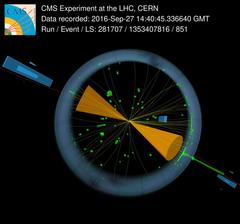An event with two jets (orange cones) from proton-proton collisions recorded in the CMS detector. The yellow lines correspond to the trajectories of the charged particles, the blue and green shaded boxes are a measure of the energy. Red lines represent the muons moving toward and passing through the muon chambers. Interactive version: [Source] . Image: CERN
A recent measurement of the strong coupling constant by the international CMS collaboration at the Large Hadron Collider is to date the most precise result achieved at a hadron collider. This fundamental parameter defines the strength of the strong force, one of the four fundamental interactions in the Universe, which holds together atomic nuclei. The high-precision analyses, which were led by DESY scientists, allow for significantly improved searches for fundamentally new interactions beyond the standard model of particle physics.
Download [276KB, 1830 x 1716]
An event with two jets (orange cones) from proton-proton collisions recorded in the CMS detector. The yellow lines correspond to the trajectories of the charged particles, the blue and green shaded boxes are a measure of the energy. Red lines represent the muons moving toward and passing through the muon chambers. Interactive version: [Source] . Image: CERN
Similar to the periodic table in chemistry, the Standard Model takes the central role in elementary particle physics. This model describes the fundamental structure and the interaction of matter. Some weaknesses of the Standard Model could hint to the presence of new elementary particles or new fundamental interactions, which would change our understanding of matter. For example, the Standard Model sorts the fundamental building blocks of matter, the quarks, into three families. However, stable nuclear matter – everything we can see and touch – is built from members of the first family only. This fact is not yet explained. One hypothesis suggests that the known quarks have a structure themselves and are subject to a yet-unknown interaction at very high energies.
The DESY group of the CMS collaboration performs searches for such new physics by studying the quark interactions at the LHC at CERN. There, strongly interacting particles called hadrons – namely, protons – are brought to collisions at very high energies. The challenge of such studies is that quarks cannot be observed as free particles, because the strong force confines them inside hadrons. Once kicked out of a proton, the quarks form sprays of collimated hadrons, called jets. By measuring the energy and the direction of a jet, scientists can deduce the properties of the quark from which it originates.
Each experimentally measured deviation of jet properties from Standard Model predictions could be a signal of new physics. The problem is that the observed jets may be produced in one of two processes: in the quark interaction driven by the unknown force, or in the strong force. Therefore, the interpretation of the measurements to a large extent relies on the precision of Standard Model parameters, particularly those of the strong force.
This problem has persisted since the first searches for new physics using jets in the 1990s in proton–antiproton collisions at the Tevatron at Fermilab in the US. The issue has now been resolved by DESY-CMS scientists, who have developed a new analysis method for simultaneous extraction of the Standard Model parameters and of the couplings mediated by the possible new interaction.
As a basis for the standard model parameters, the measurements of the HERA accelerator at DESY are used - the backbone data for any determination of the proton structure. The joint interpretation of HERA and CMS results is performed by using the unique analysis platform xFitter developed at DESY as a part of HERA data analysis.
For the first time, the data of HERA and LHC are used to simultaneously constrain the minimal energy at which the novel interaction can emerge together with the quark distributions in the proton and the strong coupling constant. The latter is determined with an accuracy of about 1.5%, which is so far the most precise single measurement at a hadron collider.
This work is supported by the Helmholtz project “Fundamental couplings at the precision frontier”.
Reference
Measurement and QCD analysis of double-differential inclusive jet cross sections in proton-proton collisions at √ s = 13 TeV; CMS Collaboration, High Energ. Phys. 2022, 142 (2022). DOI: http://dx.doi.org/10.1007/JHEP02(2022)142
Further Information
CERN News: https://cms.cern/news/jets-all-trades-constraining-standard-model-and-beyond








